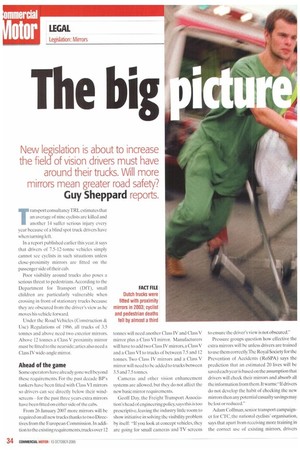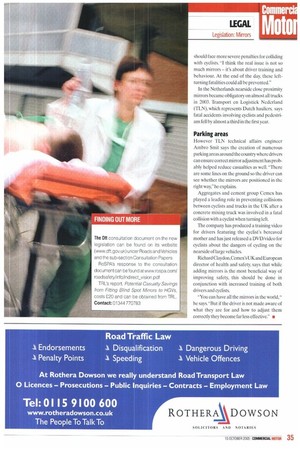The big
Page 34

Page 37

If you've noticed an error in this article please click here to report it so we can fix it.
New legislation is about to increase the field of vision drivers must have around their trucks. Will more mirrors mean greater road safety?
Guy Sheppard reports.
Transport consultancy TRL estimates that an average of nine cyclists are killed and another 14 suffer serious injury every year because of a blind spot truck drivers have when turning left.
In a report published earlier this year, it says that drivers of 7.5-12-tonne vehicles simply cannot see cyclists in such situations unless close-proximity mirrors are fitted on the passenger side of their cab.
Poor visibility around trucks also poses a serious threat to pedestrians. According to the Department for Transport (DfT), small children are particularly vulnerable when crossing in front of stationary trucks because they are obscured from the driver's view as he moves his vehicle forward.
Under the Road Vehicles (Construction & Use) Regulations of 1986, all trucks of 3.5 tonnes and above need two exterior mirrors. Above 12 tonnes a Class V proximity mirror must be fitted to the nearside; artics also need a Class IV wide-angle mirror.
Ahead of the game
Some operators have already gone well beyond these requirements. For the past decade BP's tankers have been fitted with Class VI mirrors so drivers can see directly below their windscreens — for the past three years extra mirrors have been fitted on either side of the cabs.
From 26 January 2007 more mirrors will be required on all new trucks thanks to two Directives from the European Commission. In addition to the existing requirements, trucks over 12 tonnes will need another Class IV and Class V mirror plus a Class VI mirror. Manufacturers will have to add two Class IV mirrors, a Class V and a Class VI to trucks of between 7.5 and 12 tonnes. Two Class IV mirrors and a Class V mirror will need to be added to trucks between 3.5 and 7.5 tonnes.
Cameras and other vision enhancement systems are allowed, but they do not affect the new basic mirror requirements.
Geoff Day, the Freight Transport Association's head of engineering policy, says this is too prescriptive, leaving the industry little room to show initiative in solving the visibility problem by itself: If you look at concept vehicles, they are going for small cameras and TV screens to ensure the driver's view is not obscured," Pressure groups question how effective the extra mirrors will be unless drivers are trained to use them correetly.The Royal Society for the Prevention of Accidents (RoSPA) says the prediction that an estimated 20 lives will be saved each year is based on the assumption that drivers will check their mirrors and absorb all the information from them. It warns:"If drivers do not develop the habit of checking the new mirrors then any potential casualty savings may be lost or reduced."
Adam Coffman, senior transport campaigner for crc, the national cyclists' organisation, says that apart from receiving more training in the correct use of existing mirrors, drivers should face more severe penalties for colliding with cyclists. "I think the real issue is not so much mirrors — it's about driver training and behaviour. At the end of the day, these leftturning fatalities could all be prevented."
In the Netherlands nearside close proximity mirrors became obligatory on almost all trucks in 2003. Transport en Logistiek Nederland (TLN), which represents Dutch hauliers, says fatal accidents involving cyclists and pedestrians fell by almost a third in the first year.
Parking areas
However TLN technical affairs engineer Ambro Smit says the creation of numerous parking areas around the country where drivers can ensure correct mirror adjustment has probably helped reduce casualties as well. "There are some lines on the ground so the driver can see whether the mirrors are positioned in the right way," he explains.
Aggregates and cement group Cemex has played a leading role in preventing collisions between cyclists and trucks in the UK after a concrete mixing truck was involved in a fatal collision with a cyclist when turning left.
The company has produced a training video for drivers featuring the cyclist's bereaved mother and has just released a DVD/video for cyclists about the dangers of cycling on the nearside of large vehicles.
Richard Claydon,Cemex's UK and European director of health and safety, says that while adding mirrors is the most beneficial way of improving safety, this should be done in conjunction with increased training of both drivers and cyclists "You can have all the minors in the world," he says. But if the driver is not made aware of what they are for and how to adjust them correctly they become far less effective." •












































































































































































































